A thatched roof is made using natural materials, such as straw, water reed, or palm leaves, instead of tiles or shingles.
It’s layered by hand to create a thick, sloped cover that sheds water and keeps the inside dry.
Even though we now have modern roofing options, many people are still drawn to thatched roofs. Some love the look – warm, cozy, and full of character.
In this guide, I’ll walk you through what a thatched roof is, how it’s built, where it’s still used, and the pros and cons of having one.
You’ll also learn about its history, the materials it requires, and how to care for it if you choose to pursue that route.
What Is a Thatched Roof?
A thatched roof is a roof made from layers of dried plant material – usually straw, reeds, grass, or palm leaves.
The layers are sloped to allow water to run off efficiently. As rain hits the roof, it slides down the surface without soaking through.
The thickness of the thatch also adds insulation, keeping heat in during winter and out during summer.
You’ll see them in rural villages in the UK, resorts in tropical areas, and traditional homes in Africa, Southeast Asia, and parts of Europe.
They’re also popular in historical buildings and houses that were built for their charm and character.
Materials Used for the Thatched Roof
- Cattails (Bulrushes)
- Cordage or Twine
- Wooden Poles (for Roof Frame)
- Cutting Tool (like a sickle or shears)
- Optional: Cattail Leaves or Natural Fiber Rope
Step-by-Step Guide: How to Build a Thatched Roof with Cattails
Thatching a roof with natural materials, such as cattails, is both practical and historically inspired.
Step 1: Understanding the Project
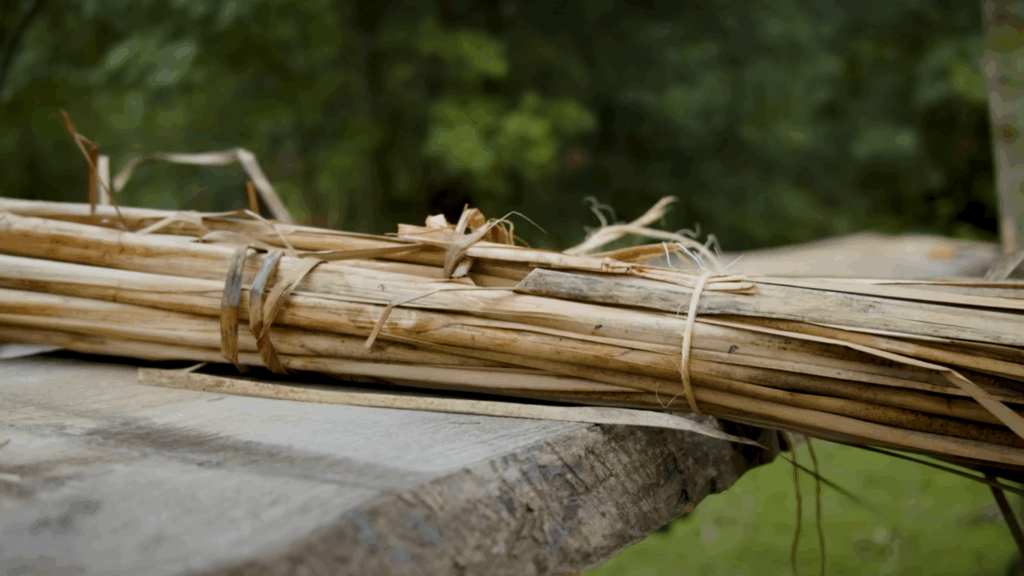
Thatching begins with a clear purpose. In this case, the goal was to cover a small outdoor structure used for woodworking or other tasks.
The builder needed a way to shield it from rain and weather without access to expensive or time-consuming materials, such as tarps or hand-split shingles.
A thatched roof made from local cattails offered a quick, cost-free solution. The idea was to layer bundles of vegetation like shingles.
Step 2: Choosing the Right Material
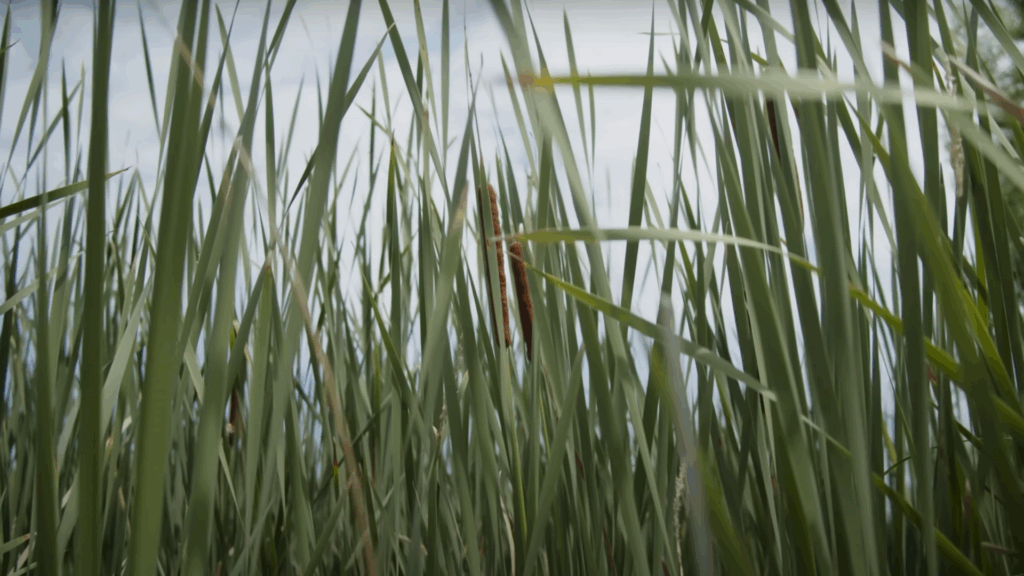
Traditional thatching typically uses long-stemmed straw or reeds, but this project relied on cattails – also known as bulrushes – harvested from nearby wetland areas.
While not the ideal thatching plant, cattails are tall, sturdy, and readily available – the longer and straighter the stalks, the better.
Some were nearly 10 feet long, making them well-suited for overlapping layers. Harvesting from the right spot ensures stronger and more usable bundles.
Step 3: Harvesting Cattails
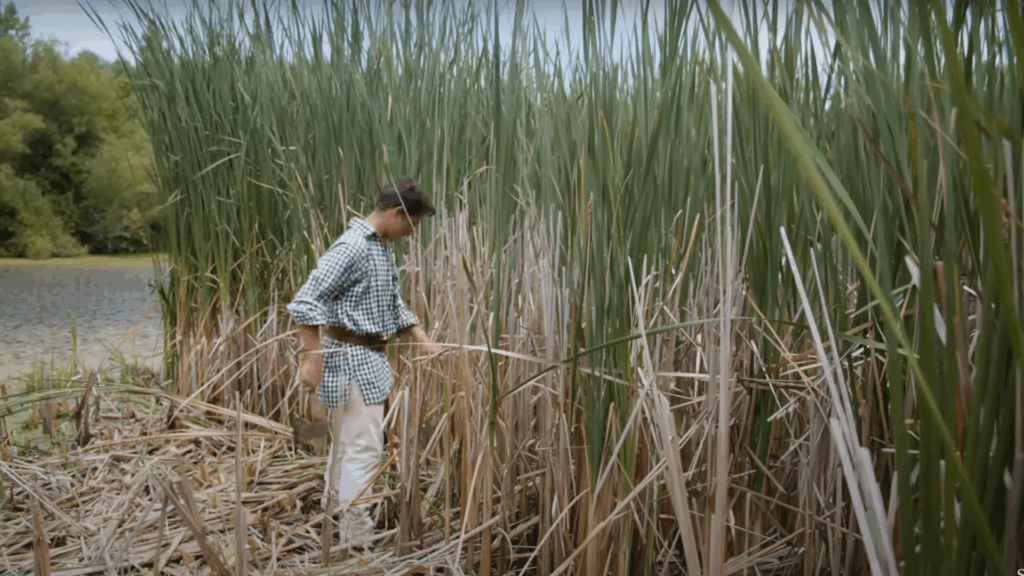
Cattails grow in shallow water and marshy areas, and the best stalks come from spots where they stretch taller. Harvesting involves cutting them as low as possible near the base.
Broken stalks lose their strength and often need trimming, reducing their usefulness. The bottom portions are the most durable, so it’s important to preserve them.
Proper harvesting takes time and patience to ensure you collect enough solid, unbroken bundles for full roof coverage.
Step 4: Bundling the Thatch
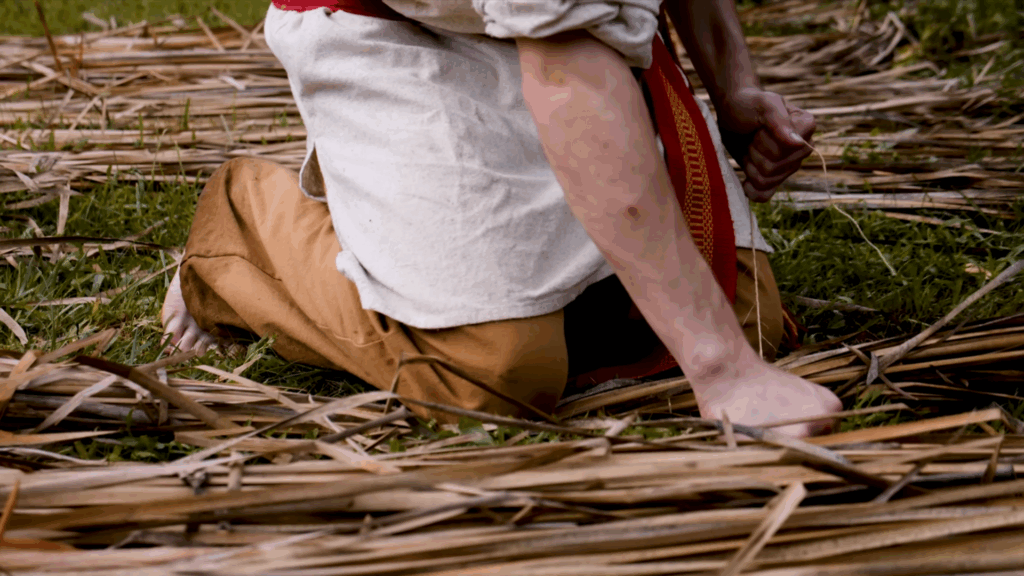
After harvesting, the cattails must be tied into bundles. Each bundle is wrapped once at the base and again near the middle to make it easier to secure to the roof frame.
While the bundles can be tied using cattail leaves, cordage or twine works better for attaching them tightly to the structure.
These bundles are the basic units of the thatch. Think of them like oversized shingles, ready to be layered in rows from the bottom up for maximum protection against rain.
Step 5: Installing the Layers
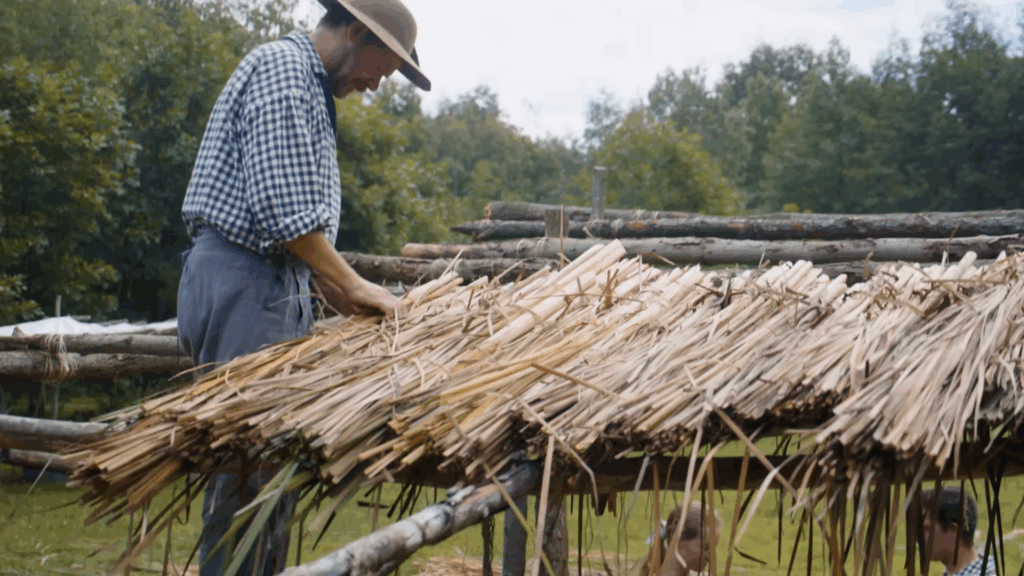
With the bundles ready, it’s time to build the roof. Thatching starts at the bottom edge and works upward in layers. Each bundle is laid slightly over the one below it, just like overlapping shingles.
The bundles are tied to the roof frame, typically with rope or wire, and placed tightly together to ensure good coverage.
A six to twelve-inch-thick layer is ideal for shedding water. Even though the cattails may still be slightly green, they’ll continue drying on the roof, hopefully without rotting.
Step 6: Evaluating and Adjusting
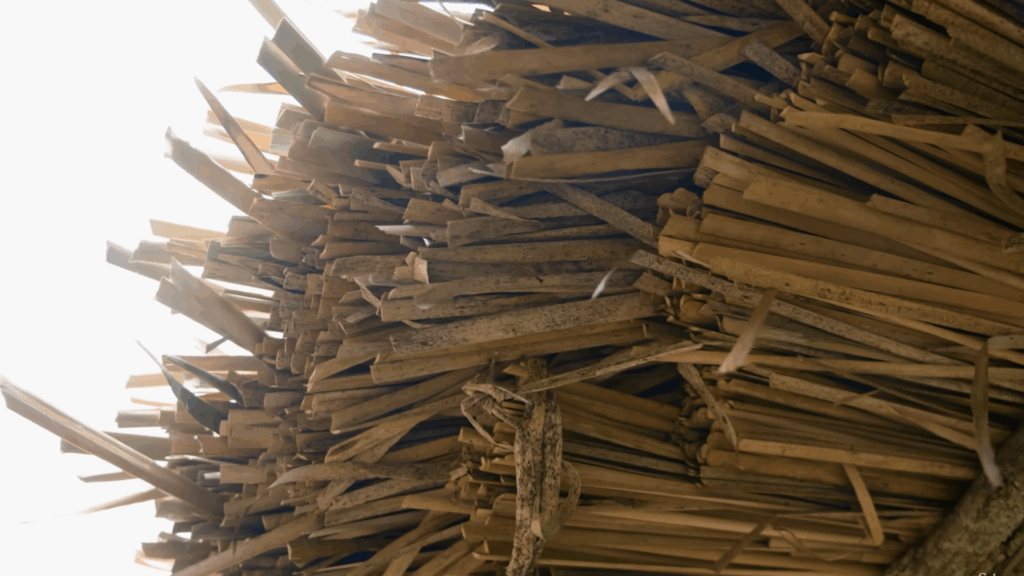
As the roof takes shape, it’s essential to check the layout and thickness regularly. More bundles might be needed than expected, especially to reach the desired depth.
The final look might not be perfect, but it’s functional and historically accurate. This type of roof may not last forever, but it serves as a valuable experiment in traditional building methods.
It demonstrates how people once utilized whatever materials were available to create shelters that were simple, effective, and rooted in their natural environment.
For a closer look at this project and to see the process in action, refer to the complete visual guide here.
Thatched Roof: Pros and Cons
Thatched roofs have a natural appearance that many people love, but they also require special care.
Before choosing one, it’s helpful to understand both the benefits and drawbacks. In the table below, I’ve broken down the main pros and cons.
| What’s Good | What to Watch Out For |
|---|---|
| Keeps heat in and out – Great natural insulation. | It can catch fire if not appropriately treated. |
| Made from plants – Straw, reed, or grass are eco-friendly. | Needs upkeep – Regular cleaning and maintenance checks are essential. |
| Looks cozy and unique – Adds charm to cottages and resorts. | Repairs cost more – Not many people know how to fix them. |
Understanding the Cost of a Thatched Roof
Thatched roofs can be more expensive than standard options, but many find the charm and insulation benefits worth the cost.
New Build vs. Repair
| Category | Cost Estimate | Details |
|---|---|---|
| New Build (Full Roof) | $10,000 – $25,000+ | Costs vary based on roof size, shape, thatch type, and location. |
| Repairs (Ridge Replacement) | $300 – $1,500 | Common repair involving replacing the ridge, depending on roof size and damage. |
| Patchwork for Worn Spots | $100 – $500 per spot | Less costly, depending on the extent of the wear. |
| Weather Wear (Maintenance) | Varies, typically $500 – $2,000 annually | More frequent in wet or windy climates; ongoing upkeep may be necessary. |
Long-Term Value
- Well-maintained thatch can last 30–40 years, while ridges typically last about 10–15 years.
- Lower heating and cooling costs due to natural insulation.
- Adds charm and uniqueness, which can raise resale value.
- Preferred in heritage or countryside homes, especially in historic areas
How to Maintain a Thatched Roof?
Thatched roofs require regular maintenance to remain in good condition. While they’re strong, they are still made from natural materials that wear down over time.
- Clear off moss, leaves, and debris to prevent moisture from settling in.
- Check the wire netting, if present, to ensure it’s secure and protecting the roof.
- If the ridge appears worn or thin, it may need replacement – this typically occurs every 10–15 years.
- Leaks, damp spots on ceilings, or sagging areas are signs that the thatch may be failing.
- Call a trained thatcher for repairs, especially for large sections or complete ridge work.
- Never wait too long, as damage can spread and become more expensive to repair later.
Thatched Roof Myths and Facts
Thatched roofs often come with a few misunderstandings. Some people view them as outdated or unreliable, but many of these perceptions aren’t accurate. Let’s clear up a few common myths:
-
“Thatched roofs always leak.”
This is false. A well-built thatched roof is tightly packed and carefully sloped to shed water. If maintained properly, it stays dry inside – even in heavy rain. -
“They attract pests like birds or insects.”
Not always. If the roof is built and sealed correctly, pests are not a big problem. Netting can also help keep animals out. Regular upkeep keeps issues small. -
“Thatched roofs are only for old houses.”
While they’re common on historic homes, modern builders still use them in eco-resorts and custom cottages. With updated designs and treatments, they are suitable for both old and new homes.
Conclusion
Thatched roofs may be one of the oldest roofing methods, but they’re still practical and beautiful today.
They offer natural insulation, unique charm, and a connection to traditional craftsmanship that you won’t find with modern materials.
With the proper care and regular upkeep, a thatched roof can last for decades. It might take a bit more attention, but many homeowners find the look and feel well worth the effort.
If you love the idea of a warm, natural home with character – and you’re okay with some maintenance – a thatched roof could be a perfect fit.
It’s not for every setting, but in the right place, it adds lasting value and timeless style.

